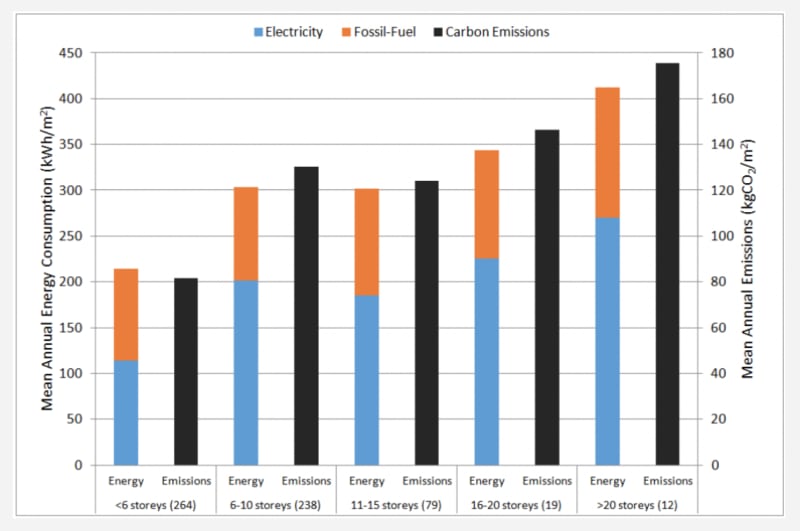High-Rise Buildings: Energy and Density

This project was carried out in 2015-2017 by Ian Hamilton, Daniel Godoy-Shimizu, Homeira Shayesteh, Stephen Evans, Graciela Moreno, Michael Donn and myself. It was funded by the Engineering and Physical Sciences Research Council. The project set out to answer two questions. 1: Are high-rise buildings more energy-intensive – all other things being equal – than low-rise buildings? 2: Is it possible to provide the same floor area on the same site as high-rise buildings, but on a much-reduced number of storeys? The results showed conclusively that the answer to both questions is ‘Yes’. It follows that much energy could be saved by discouraging tall buildings and encouraging low-rise in their place.
A sample of some 600 office buildings of different heights was selected, and their actual annual use of energy compared. Energy use and floor area data came from three sources: Display Energy Certificates, the Better Buildings Partnership, and the London Mayor’s Energy Challenge. The buildings are all in the UK, the majority in London. They range in height from 2 storeys to more than 30 storeys. Some are air-conditioned, others mechanically or naturally ventilated. Some are commercial offices, others public. Their dates of construction range from pre-1900 to the present.

The figure shows overall energy performance and carbon emissions for the sample, against height. Mean fossil fuel use is shown in orange, and mean electricity use in blue: the scale (kWh/m2) is at the left. Carbon emissions are shown in black: the scale (kg CO2/m2) is at the right. Comparing buildings on 6 storeys and fewer (‘low-rise’) with buildings on 20 storeys and more (‘high-rise’), electricity use in the high-rise is nearly two and a half times greater than in the low-rise (a 135% increase). The increase in fossil fuel use (by 40%) is less marked. Carbon emissions are more than doubled going from ‘low-rise’ to ‘high-rise’. The magnitude of this effect was unexpected, and had not been previously demonstrated.
A statistical study of aggregate energy use in residential buildings was made at the level of Lower Super Output Areas (spatial units used for Census purposes, containing typically 400 to 1200 dwellings) in twelve London boroughs. Total numbers of floors in all these buildings were compared with total annual gas and electricity use. By contrast with offices, the results showed only a small increase in the intensity of electricity use with height, but a very marked increase in the intensity of gas use.
Follow-up work is planned, to investigate the reasons for these striking effects: in particular, the possibility that they are caused by the exposure of taller buildings to lower temperatures, stronger winds, and greater solar gains. The research would draw much larger samples of office and residential buildings from the 3DStock model of London